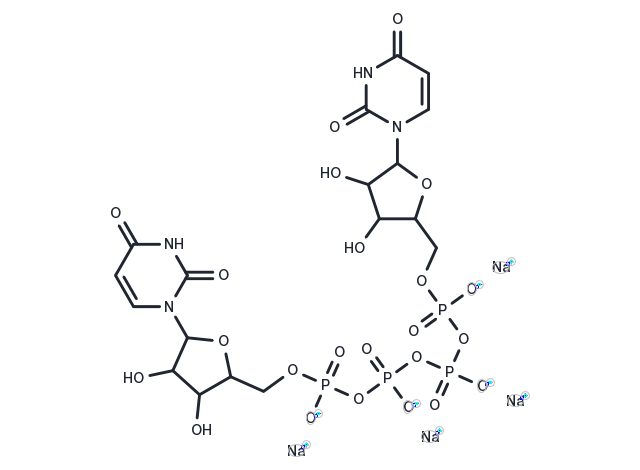keep away from direct sunlight,store under nitrogen
Powder: -20°C for 3 years | In solvent: -80°C for 1 year
Diquafosol Tetrasodium is a P2Y2 receptor agonist that stimulates the secretion of mucins from ocular tissues Diquafosol tetrasodium (INS365) improves tear film stability and visual function, as a topical treatment of dry eye disease.

| パッケージサイズ | 在庫状況 | 単価(税別) | |||
|---|---|---|---|---|---|
| サンプルについてお問い合わせ | |||||
| 2 mg | 在庫あり | ¥ 9,000 | |||
| 5 mg | 在庫あり | ¥ 15,000 | |||
| 10 mg | 在庫あり | ¥ 22,500 | |||
| 25 mg | 在庫あり | ¥ 44,000 | |||
| 50 mg | 在庫あり | ¥ 75,500 | |||
| 100 mg | 在庫あり | ¥ 114,000 | |||
| 500 mg | 在庫あり | ¥ 248,000 | |||
| 説明 | Diquafosol Tetrasodium is a P2Y2 receptor agonist that stimulates the secretion of mucins from ocular tissues Diquafosol tetrasodium (INS365) improves tear film stability and visual function, as a topical treatment of dry eye disease. |
| In vitro | duration of exposure and diquafosol concentration significantly reduced cell survival and increased cell lysis.?On the other hand, no significant difference was observed in HA groups regardless of exposure time.?Cell viability significantly decreased after treatment for 1 hour with 30% diluted diquafosol and after treatment for 6 hours with all diluted diquafosol.?After treatment with all diluted diquafosol for 24 hours, cell viability decreased and lysis increased, and significant cellular damage was observed[1]. |
| In vivo | In a rat dry eye model, the P2Y(2) agonist INS365 was found to improve surface health, based on increases in tear fluid secretion, corneal epithelial resistance, and release of glycoprotein-containing moieties from goblet cells.??INS365 is a potential therapeutic agent for use in the treatment of dry eye syndrome[2]. |
| 細胞研究 | The viabilities of human corneal epithelial cells (HCECs) were determined using a MTT assay.?Cells (100 μl;?5×104 cell/mL) were plated in 96-well tissue-culture plates and incubated at 37℃ in 5% CO2 for 24 to 48 h until cultures were subconfluent.?Diquafosol (100 μl diluted 10%, 20%, or 30%) or 0.3% or 0.18% HA were added and incubated for 1, 6, or 24 h. DMEM (100 μl) was added to controls.?After 1, 6, and 24 h, plates were washed three times with PBS to remove the drugs.?Cell viabilities were evaluated after incubating for 24 h. MTT (3-(4,5-dimethylthiazol-2-yl)-2,5-diphenyltetrazolium bromide;?thiazoyl blue (5 mg/mL) was then added to each well.?Samples were incubated in the dark for 4 h at 37℃, and media were then removed.?Precipitates were resuspended indimethyl sulfoxide (100 μl;?DMSO, Sigma-Aldrich).?Absorbances were measured on a plate reader at 570 nm.?The experiment was performed in triplicate[1]. |
| 動物実験 | An SD rat dry eye model was used in which exorbital lacrimal gland extirpation decreased the Schirmer test score by at least 50%. After 8 weeks, when significant increases occurred in corneal epithelial permeability, Diquafosol tetrasodium(INS365)-containing eye drops were applied six times daily for the next 4 weeks at concentrations from 0.03% to 3.0%. Corneal barrier function was evaluated based on measurements with a modified anterior fluorometer of fluorescein penetrance at 1, 2, and 4 weeks after initial application. After INS365 application, the periodic acid-Schiff reagent (PAS)-stained area was evaluated in histologic sections of the tarsal and bulbar conjunctiva[2]. |
| 別名 | INS365 |
| 分子量 | 878.23 |
| 分子式 | C18H22N4Na4O23P4 |
| CAS No. | 211427-08-6 |
keep away from direct sunlight,store under nitrogen
Powder: -20°C for 3 years | In solvent: -80°C for 1 year
H2O: 10 mM
DMSO: Insoluble
You can also refer to dose conversion for different animals. 詳細
bottom
Please see Inhibitor Handling Instructions for more frequently ask questions. Topics include: how to prepare stock solutions, how to store products, and cautions on cell-based assays & animal experiments, etc.
Diquafosol tetrasodium 211427-08-6 GPCR/G Protein Neuroscience P2Y Receptor Inhibitor inhibit INS 365 Diquafosol INS-365 INS365 inhibitor
